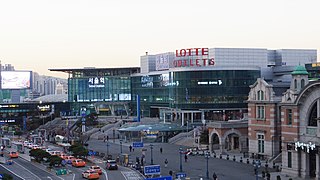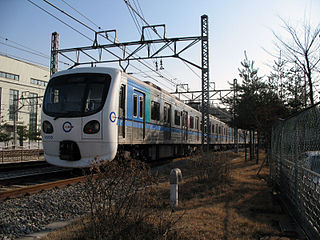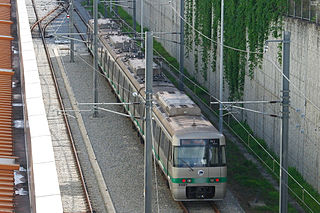
- Seoul Capital Area - 22 lines
- Busan - 6 lines
- Daegu - 3 lines
- Daejeon - 1 line
- Gwangju - 1 line
Rapid transit systems operate in six major South Korean cities, except for Sejong.

Rapid transit systems operate in six major South Korean cities, except for Sejong.
| Rapid transit systems | |||||||
|---|---|---|---|---|---|---|---|
| System | Locale | Lines | Stations | Length (km) | Commencement | ||
| Seoul Subway (inc. Incheon Subway) | Seoul Capital Area | 23 | 768 | 1,262.2 | 15 August 1974 | ||
| Busan Metro | Busan–Gyeongnam Area | 6 | 158 | 205.6 | 19 July 1985 | ||
| Daegu Metro | Daegu–Gyeongbuk Area | 3 | 90 | 83.7 | 26 November 1997 | ||
| Gwangju Metro | Gwangju | 1 | 20 | 20.6 | 28 April 2004 | ||
| Daejeon Metro | Daejeon | 1 | 22 | 22.7 | 16 March 2006 | ||
| Rapid transit lines in Busan | ||||||
|---|---|---|---|---|---|---|
| Operator | Livery | Line | Stations | Length (km) | Terminuses | Commencement |
| Busan Transportation Corp. | | Busan Metro Line 1 | 40 | 40.5 | Sinpyeong—Nopo | 19 July 1985 |
| | Busan Metro Line 2 | 42 | 45.2 | Jangsan—Yangsan | 30 June 1999 | |
| | Busan Metro Line 3 | 17 | 18.3 | Suyeong—Daejeo | 28 November 2005 | |
| | Busan Metro Line 4 | 14 | 12.7 | Minam—Anpyeong | 30 March 2011 | |
| B&G Metro | | Busan–Gimhae Light Rail Transit | 21 | 23.4 | Sasang—Kaya University | 9 September 2011 |
| Korail | | Donghae Line | 23 | 65.7 | Bujeon—Taehwagang | 30 December 2016 |
| Rapid transit lines in Daegu | ||||||
|---|---|---|---|---|---|---|
| Operator | Livery | Line | Stations | Length (km) | Terminuses | Commencement |
| Daegu Metropolitan Transit | | Daegu Metro Line 1 | 30 | 25.9 | Daegok—Ansim | 26 November 1997 |
| | Daegu Metro Line 2 | 29 | 31.4 | Munyang—Yeungnam University | 18 October 2005 | |
| | Daegu Metro Line 3 | 30 | 23.9 | KNU Medical Center—Yongji | 23 April 2015 | |
| Rapid transit lines in Daejeon | ||||||
|---|---|---|---|---|---|---|
| Operator | Livery | Line | Stations | Length (km) | Terminuses | Commencement |
| Daejeon Metropolitan Express Transit | | Daejeon Metro Line 1 | 22 | 22.7 | Panam—Banseok | 16 March 2006 |
| Rapid transit lines in Gwangju | ||||||
|---|---|---|---|---|---|---|
| Operator | Livery | Line | Stations | Length (km) | Terminuses | Commencement |
| Gwangju Metropolitan Rapid Transit | | Gwangju Metro Line 1 | 20 | 20.6 | Nokdong—Pyeongdong | 28 April 2004 |
Transportation in South Korea is provided by extensive networks of railways, highways, bus routes, ferry services and air routes that traverse the country. South Korea is the third country in the world to operate a maglev train, which is an automatically run people mover at Incheon International Airport.

The Seoul Metropolitan Subway is a metropolitan railway system consisting of 23 rapid transit, light metro, commuter rail and people mover lines located in northwest South Korea. The system serves most of the Seoul Metropolitan Area including the Incheon metropolis and satellite cities in Gyeonggi province. Some regional lines in the network stretch out beyond the Seoul Metropolitan Area to rural areas in northern Chungnam province and western Gangwon province, that lie over 100 km (62 mi) away from the capital.

The Korea Railroad Corporation, branded as KORAIL, is the national railway operator in South Korea. Currently, KORAIL is a public corporation, managed by Ministry of Land, Infrastructure and Transportation.

The Gyeongbu line (Gyeongbuseon) is a railway line in South Korea and is considered to be the most important and one of the oldest ones in the country. It was constructed in 1905, connecting Seoul with Busan via Suwon, Daejeon, and Daegu. It is by far the most heavily travelled rail line in South Korea.

Seoul Station (Korean: 서울역) is a major railway station in Seoul, the capital of South Korea. The station is served by the Korail Intercity Lines and the commuter trains of the Seoul Metropolitan Subway.

Seoul Subway Line 1 of the Seoul Metropolitan Subway is a rapid transit and commuter rail line which links central Seoul, South Korea to Yeoncheon in the northeast, Incheon in the southwest, and Sinchang via Suwon and Cheonan in the south. The central underground portion of Line 1, running underneath Sejongno, Jongno, and Wangsan-ro avenues along Seoul's traditional downtown area, is the oldest subway-operated section in the Seoul Metropolitan Subway system. Its branches and services cover a large part of the Seoul Capital Area; totaling 200.60 km (124.65 mi) in route length.

The Incheon Subway is a subway system serving the South Korean city of Incheon. The system is operated by Incheon Transit Corporation, and is part of the greater Seoul Metropolitan Subway.
Green Line may refer to:

Incheon Subway Line 1 is a 29.4-kilometer (18.3 mi) north-south subway line, part of the Incheon Subway system. The line is also included as a part of the overall Seoul Metropolitan Subway network; Bupyeong Station has a free transfer with Seoul Subway Line 1, Gyeyang Station connects with the AREX Line which leads to Incheon International Airport and Seoul Station, Bupyeong-gu Office Station has a free transfer with Seoul Subway Line 7, and Woninjae Station has a free transfer with the Suin-Bundang Line.

T-money is a rechargeable series of smart cards and other "smart" devices used for paying transportation fares in and around Seoul and other areas of South Korea. T-money can also be used in lieu of cash or credit cards in some convenience stores and other businesses. The T-money System has been implemented and is being operated by T-money Co., Ltd of which 34.4% owned by Seoul Special City Government, 31.85% owned by LG CNS, and 15.73% owned by Credit Card Union.

Daejeon Subway Line 1 is a subway line is located in Daejeon, South Korea. After excluding the Seoul metropolitan area, it was the fourth subway line created in South Korea, following Busan, Daegu, and Gwangju. Its line color is ● green. It is 22.6 km (14.0 mi) long with 22 stations. It is the first of five planned lines for the Daejeon Metro.

The Commuter Train were a class of short-run commuter trains operated by Korail, the national railroad of South Korea. They operated once or twice daily in each direction, along a few tens of kilometers of track. They provided an important function for many smaller rural communities, which often lack good transit connections. Commuter Train operations on the Gyeongwon line was temporarily suspended its operation on April 1, 2019, due to the construction and partial electrification of the line for the Soyosan-Yeoncheon extension of Seoul Subway Line 1. They were permanently suspended on December 16, 2023, after the opening of the extension, and due to the old age of CDC trains. Commuter trains last operated on the Gwangju Line in Gwangju between GwangjuSongjeong and Gwangju station, from January 1, 2020, until December 17, 2023, permanently being phased out due to the old age of CDC trains.

AREX is a South Korean airport rail link and commuter rail line that links Incheon International Airport with Seoul Station via Gimpo International Airport. The section between the two airports opened on March 23, 2007, and line was extended to Seoul Station on December 29, 2010. Long-distance Korea Train Express high speed trains started to use the line from June 30, 2014, but discontinued service in March 2018 due to low ridership.

Rail transport in South Korea is a part of the transport network in South Korea and an important mode of the conveyance of people and goods, though railways play a secondary role compared to the road network. The network consists of 4,285 km (2,663 mi) of standard-gauge lines connecting all major cities with the exception of Jeju City on Jeju Island, which does not have railways; of the network, 2,790 km (1,730 mi) are double-tracked and 3,187 km (1,980 mi) are electrified. In 2018, rails carried 11.5 percent of all traffic in South Korea – 134.8 million passengers and 30.9 million tonnes of freight – with roads carrying 88.3 percent.

The history of rapid transit began in London with the opening of the Metropolitan Railway, which is now part of the London Underground, in 1863. By World War I, electric underground railways were being used in Athens, Berlin, Boston, Buenos Aires, Budapest, Glasgow, Hamburg, Istanbul, Liverpool, New York City, Paris, and Philadelphia.

The Gyeongbu high-speed railway, also known as Gyeongbu HSR, is South Korea's first high-speed rail line from Seoul to Busan. KTX high-speed trains operate three sections of the line: on 1 April 2004, the first between a junction near Geumcheon-gu Office station, Seoul and a junction at Daejeonjochajang station north of Daejeon, and a second between a junction at Okcheon station, southeast of Daejeon, and a junction near Jicheon station, north of Daegu entered service; then on 1 November 2010, the third section, between a junction west of Daegu and Busan became operational. The missing gaps across the urban areas of Daejeon and Daegu were in construction for an expected opening in 2014, separate tracks into Seoul Station were also planned. The temporary ends of the three sections were connected to the parallel conventional Gyeongbu Line by tracks that will serve as interconnector branches upon the completion of the entire line. On 1 August 2015, construction on urban areas of Daejeon and Daegu were completed; all the sections of HSR line were connected.

Incheon Transit Corporation (인천교통공사), formerly known as Incheon Rapid Transit Corporation (인천지하철공사) currently operates the Incheon Subway, Wolmi Sea Train, Incheon Bus information, Incheon Bus Terminal, Call taxi for the handicapped in Incheon, South Korea, established in 1993. In 2011 Incheon Transit Corporation merged with ′Incheon Metro′, established in 1998 to operate Incheon Subway Line 1, Incheon Subway Line 2, the section of Seoul Subway Line 7 between Kkachiul & Seongnam, & the Incheon Airport Maglev. In the future it also has plans to operate Line 3.
High-speed rail service in South Korea began with the construction of a high-speed line from Seoul to Busan in 1992, and was inspired by Japan's Shinkansen. The first commercial high-speed rail service was launched on April 1, 2004. Currently, South Korea hosts two high-speed rail operators: Korea Train eXpress (KTX) and Super Rapid Train (SRT).

Seoul Transportation Corporation, branded as Seoul Metro, is a municipal-owned corporation owned by Seoul Metropolitan Government, and one of the two major operators of Seoul Metropolitan Subway with Korail.

Station numbering is a sign system which assigns station codes consisting of a few letters and numbers to train stations. It aims to facilitate navigation for foreign travelers not familiar with the local language by using globally understood characters. The system is now in use by various railway companies around the world such as in Mainland China, Indonesia, Japan, South Korea, Singapore, Taiwan, Thailand, and the United States.